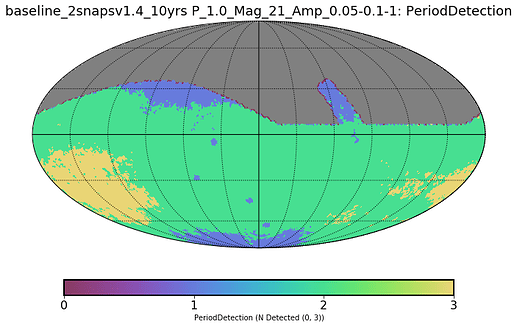I’d like to bring your attention to some newly released runs which may be of particular interest to the Transients and Variables community.
These runs vary the u-band filter loading time, vary the pairing of u band with g and r band visits, and there are also a series of runs where a third visit in g, r, or i is made on a variable percent of nights.
The basic filter-loading variations (which are similar to those in FBS 1.3) are found in the filter_load directory. The ‘illum_*’ reflects when the u band is swapped.
A perhaps more interesting version of these filter-loading variations is found in u_pairs, where the u band visits are paired with g or r band, with a slightly varying fraction of visits being take in u band to make more or less pairs.
The other investigation, of a different nature, is to add a third visit in either g, r or i band at the end of each night, to fields which already obtained a pair earlier in the night. The amount of time available for these ‘third’ visits is varied across the different runs. These are available in third_obs.
As a reminder, there is also a previously released set of runs where the pair-strategy within each night is varied, in pair_strat.
We have (our) metrics available for these runs at http://astro-lsst-01.astro.washington.edu:8082/
The ScienceRadar set of metric outputs has some new additions in the Transients and Variables category!
http://astro-lsst-01.astro.washington.edu:8082/allMetricResults?runId=17#Variables/Transients
The addition includes a metric evaluating the possibility of detecting variability (compared to no-variability) for periodic variables with a period of 0.2, 1, or 2 days, with amplitudes of between 0.05 to 1 magnitudes. For objects of a given brightness (21 or 24 mag), and the given period, the metric reports a value of between 0 to 3 … 0 = could not confirm variability, 1 = could confirm variability at 1 mag level, 2 = could confirm variability at the level of 0.1 mag, and 3 = could confirm variability at the level of 0.05 mag (sorry for the typos in the captions … it should be 0.05 mag not 0.5 mag, and the period/mag are apparently switched as well). A longer example of this metric, without combining the various amplitudes into the output, is provided at https://github.com/rhiannonlynne/notebooks/blob/master/periodicity%20check.ipynb
Example – this shows the possibility of detecting simple periodicity with P=1 day, for an r=21 mag star, at varying amplitudes. 0 = could not detect variability, 1 = could detect variability at 1 mag, 2 = could detect variability at 0.1 mag, 3 = could detect variability at 0.05 mag level.
